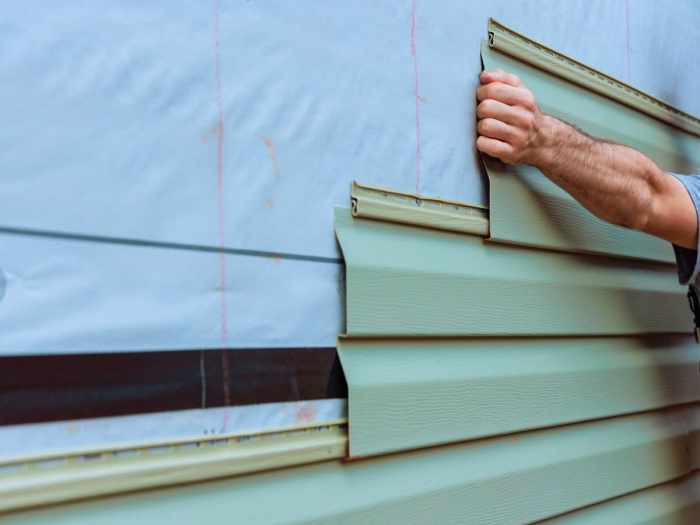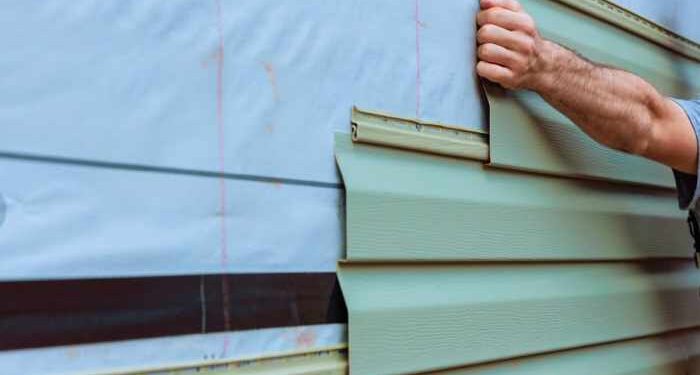Embark on a journey to master the art of installing siding with our comprehensive DIY guide. From choosing the right materials to perfecting the finishing touches, this guide will equip you with the knowledge and skills needed to revamp your home exterior with confidence.
As we delve deeper into the intricacies of siding installation, you'll uncover valuable insights and practical tips to ensure a successful project from start to finish.
Preparation
Before you start installing siding on your own, it is important to gather all the necessary tools and materials. Additionally, preparing the work area and considering safety measures are essential steps to ensure a successful installation process.
Tools and Materials Needed
- Vinyl siding panels
- Siding nails
- J-trim
- Caulk gun
- Tape measure
- Level
- Tin snips
- Utility knife
- Safety glasses
- Gloves
Preparing the Work Area
Before you begin installing siding, make sure the work area is clean and free of any obstacles. Remove any debris or loose materials that could interfere with the installation process. This will help ensure a smooth and efficient installation.
Safety Measures
- Wear safety glasses to protect your eyes from any debris.
- Use gloves to protect your hands while handling sharp tools and materials.
- Ensure the work area is well-lit to avoid accidents or mistakes.
- Be cautious when using ladders or working at heights to prevent falls.
- Follow manufacturer's instructions and recommendations for safe installation practices.
Choosing the Right Siding
When it comes to choosing the right siding for your DIY installation project, there are several factors to consider. From durability to aesthetics, each type of siding material has its own set of pros and cons. Let's take a closer look at some popular siding options and discuss how to select the most suitable one based on your specific needs.
Vinyl Siding
Vinyl siding is one of the most popular choices for homeowners due to its affordability and low maintenance requirements. It comes in a variety of colors and styles, making it a versatile option for many different home designs. However, it may not be as durable as other materials and can crack or fade over time.
Wood Siding
Wood siding provides a natural and timeless look to your home. It can be painted or stained in various colors to match your preferences. While wood siding offers excellent insulation properties, it requires regular maintenance to prevent rot, pests, and mold growth.
Fiber Cement Siding
Fiber cement siding is a durable and low-maintenance option that can mimic the look of wood or stucco. It is resistant to rot, fire, and pests, making it a long-lasting choice for many homeowners. However, it can be heavier and more challenging to install compared to other materials.
Metal Siding
Metal siding, such as aluminum or steel, is known for its strength and longevity. It is resistant to rot, insects, and fire, making it a popular choice in areas with extreme weather conditions. However, metal siding can be prone to dents and scratches, affecting its appearance over time.
Choosing Based on Climate and Budget
When selecting the right siding material, consider the climate of your area. For instance, if you live in a region with high humidity or frequent rain, moisture-resistant materials like vinyl or fiber cement may be more suitable. Additionally, factor in your budget and long-term maintenance costs to make an informed decision that fits your financial constraints.
Measuring and Calculating
Accurately measuring and calculating the dimensions of your exterior walls is crucial for a successful siding installation project. Proper measurements ensure you order the correct amount of siding and minimize waste. Here's how you can do it:
Measuring the Exterior Walls
To measure the dimensions of your exterior walls, follow these steps:
- Start by measuring the width and height of each wall in feet.
- Calculate the square footage of each wall by multiplying the width by the height.
- Sum up the square footage of all walls to get the total square footage needed for siding.
Calculating Siding Amount
Once you have the total square footage, consider the siding's coverage area per piece to calculate the quantity needed:
- Divide the total square footage by the coverage area of one piece of siding.
- Round up to the nearest whole number to ensure you have enough siding for the project.
- Add a small percentage (usually 10%) to account for waste and cutting.
Common Mistakes to Avoid
When measuring and calculating for siding installation, watch out for these common mistakes:
- Not measuring each wall individually can lead to ordering insufficient siding.
- Forgetting to account for doors, windows, and other openings can result in inaccurate measurements.
- Underestimating waste and cutting needs may leave you short on siding during installation.
- Not double-checking calculations can lead to ordering the wrong amount of siding.
Installation Process
Installing siding on a wall involves a step-by-step process that ensures a proper and durable finish. Here, we will explain how to prepare the surface, apply underlayment, and secure the siding panels, as well as provide tips on cutting and fitting siding around windows, doors, and corners.
Preparation of the Surface
Before installing siding, it is crucial to prepare the surface properly. This involves cleaning the wall to remove any dirt, debris, or peeling paint. Additionally, make sure the wall is smooth and free of any imperfections that could affect the siding installation.
- Use a power washer or scrub brush to clean the wall thoroughly.
- Repair any cracks or damage to the wall surface before proceeding.
- Allow the wall to dry completely before moving on to the next step.
Applying Underlayment
Underlayment is essential for providing an additional layer of protection against moisture and improving the insulation of your home. Here's how to apply underlayment before installing the siding panels:
- Measure and cut the underlayment to fit the dimensions of the wall.
- Secure the underlayment to the wall using a hammer or staple gun.
- Overlap the underlayment sheets to ensure complete coverage and protection.
Securing Siding Panels
Securing the siding panels properly is crucial for a neat and durable finish. Follow these steps to secure the siding panels effectively:
- Start at the bottom of the wall and work your way up, overlapping each panel for proper drainage.
- Secure the panels to the wall using nails or screws, following the manufacturer's guidelines.
- Use a level to ensure the panels are straight and aligned correctly.
Cutting and Fitting Around Windows, Doors, and Corners
When it comes to fitting siding around windows, doors, and corners, precision is key. Here are some tips to help you cut and fit siding around these areas seamlessly:
- Measure and mark the areas where the siding needs to be cut to fit around windows, doors, and corners.
- Use a circular saw or tin snips to make precise cuts in the siding material.
- Fit the cut pieces around windows, doors, and corners carefully to ensure a tight and secure fit.
Finishing Touches

Proper finishing touches are essential to ensure that your siding remains weatherproof and maintains a professional appearance. By following the right steps for caulking, trimming, and painting or staining, you can enhance the longevity and aesthetic appeal of your siding.
Caulking Joints
- Inspect all joints and gaps in the siding carefully to identify any areas that may allow water infiltration.
- Use a high-quality exterior caulk to seal any seams, corners, or edges where water can penetrate.
- Apply the caulk evenly and smoothly, ensuring complete coverage to prevent moisture from seeping behind the siding.
- Allow the caulk to dry completely before proceeding with any painting or staining.
Trimming Edges
- Trim the edges of the siding neatly and precisely to create a clean and polished look.
- Use a sharp utility knife or saw to cut the siding to the desired length, making sure to follow the manufacturer's guidelines.
- Sand down any rough edges or uneven surfaces to ensure a seamless finish.
- Secure the trimmed pieces firmly in place to prevent any shifting or gaps.
Painting or Staining
- If you choose to paint or stain your siding, make sure to select a high-quality product designed for exterior use.
- Prepare the surface by cleaning it thoroughly and allowing it to dry completely before applying any paint or stain.
- Apply the paint or stain evenly and according to the manufacturer's instructions to achieve a uniform finish.
- Consider applying a second coat for added protection and enhanced color durability.
Maintenance Tips
- Regularly inspect the siding for any signs of damage, such as cracks, peeling paint, or discoloration.
- Clean the siding periodically using a mild detergent and water to remove dirt, mold, and mildew buildup.
- Trim any overhanging trees or bushes to prevent damage to the siding from branches or debris.
- Consider applying a fresh coat of paint or stain every few years to refresh the appearance and provide additional protection against the elements.
Closure

As you wrap up your siding installation project armed with newfound expertise, remember that attention to detail and precision are key to achieving a professional result. With the right guidance and a touch of creativity, you can transform your home's appearance and enhance its durability for years to come.
FAQ Explained
What are the common tools and materials needed for installing siding?
Tools typically include a hammer, tape measure, circular saw, and materials like siding panels, nails, and underlayment.
How do I choose the right siding material based on my climate and budget?
Consider factors like durability, maintenance requirements, and cost when selecting from options such as vinyl, wood, fiber cement, and metal.
What are the key steps in the installation process of siding?
Steps involve preparing the surface, securing siding panels, and carefully fitting them around windows, doors, and corners for a seamless finish.
Why is proper finishing essential for siding installation?
Finishing ensures weatherproofing, and sealing joints, edges, and applying paint or stain adds a professional touch while protecting the siding.
How can I maintain the siding after installation to extend its lifespan?
Regular maintenance like cleaning, inspections for damage, and prompt repairs can help prolong the lifespan of your siding and preserve its appearance.



